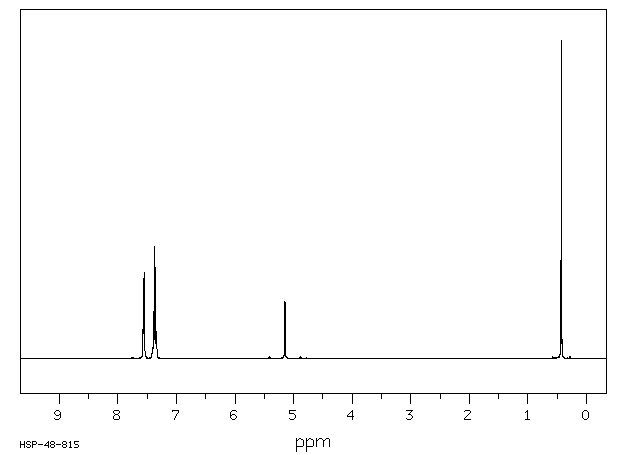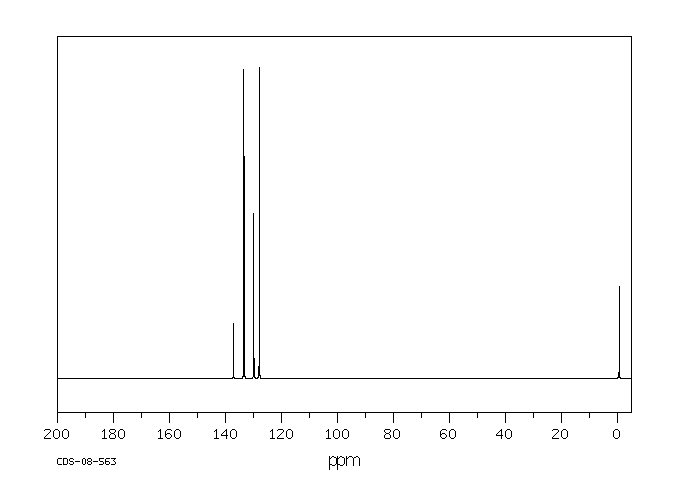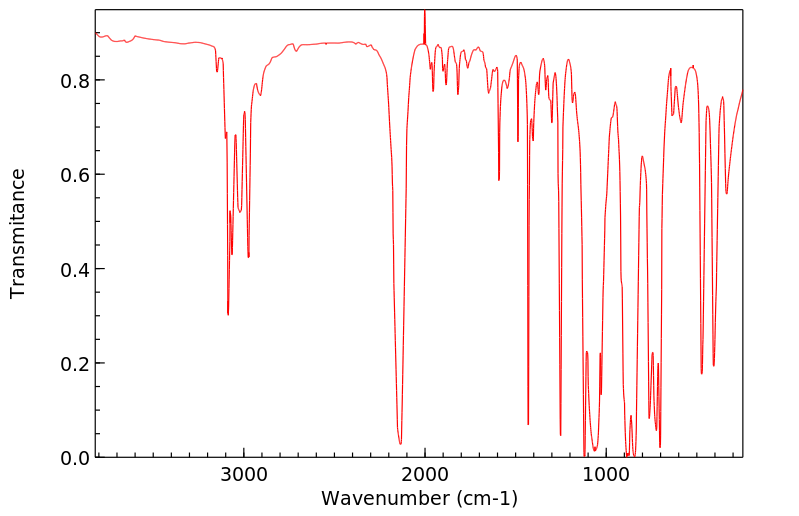1,3-二苯基-1,3-二甲基二硅烷 | 6689-22-1
中文名称
1,3-二苯基-1,3-二甲基二硅烷
中文别名
——
英文名称
1,3-dimethyl-1,3-diphenyldisiloxane
英文别名
1,3-Dimethyl-1,3-diphenyl-disiloxan;Methyl-[methyl(phenyl)silyl]oxy-phenylsilane
CAS
6689-22-1
化学式
C14H18OSi2
mdl
——
分子量
258.467
InChiKey
RMZSTOAGUSEJFY-UHFFFAOYSA-N
BEILSTEIN
——
EINECS
——
-
物化性质
-
计算性质
-
ADMET
-
安全信息
-
SDS
-
制备方法与用途
-
上下游信息
-
文献信息
-
表征谱图
-
同类化合物
-
相关功能分类
-
相关结构分类
物化性质
-
沸点:120 °C(Press: 2 Torr)
-
密度:0.996 g/cm3(Temp: 25 °C)
计算性质
-
辛醇/水分配系数(LogP):1.52
-
重原子数:17
-
可旋转键数:4
-
环数:2.0
-
sp3杂化的碳原子比例:0.14
-
拓扑面积:9.2
-
氢给体数:0
-
氢受体数:1
安全信息
-
海关编码:2934999090
SDS
上下游信息
-
上游原料
中文名称 英文名称 CAS号 化学式 分子量 —— 1,3-diphenyldisiloxane 17962-59-3 C12H14OSi2 230.414
反应信息
-
作为反应物:描述:甲醇 、 1,3-二苯基-1,3-二甲基二硅烷 在 Wilkinson's catalyst 作用下, 以 苯 为溶剂, 反应 12.0h, 以78%的产率得到1,3-二甲基-1,3-二苯基-1,3-二甲氧基二硅氧烷参考文献:名称:1,3-Dimethoxy-1,3-dimethyl-1,3-diphenyl- and 1,3-dimethoxy-1,3-tetraphenyldisiloxanes: synthesis and structure摘要:合成了 1,3-二甲氧基-1,3-二甲基-1,3-二苯基和 1,3-二甲氧基-1,3-四苯基二硅氧烷。红外光谱和核磁共振光谱证实了它们的结构。通过 X 射线衍射确定了 1,3-二甲氧基-1,3-四苯基二硅氧烷的结构。DOI:10.1007/s11172-019-2596-y
-
作为产物:描述:甲基苯基硅烷 在 gold nanoparticles stabilized by [HOCH2CH2SCH2CH2SiMeO]4 、 air 作用下, 以95%的产率得到1,3-二苯基-1,3-二甲基二硅烷参考文献:名称:在水-氯仿界面上具有金纳米颗粒组装的二有机硅烷催化氧化为1,1,3,3-四有机二硅氧烷†摘要:通过使用环四硅氧烷[RSCH 2 CH 2 SiMeO] 4(R = CH 2 CH 2 OH)作为水,在水-氯仿界面上形成200±20 nm尺寸的金纳米颗粒(AuNPs)的球形自组装体。稳定配体。界面稳定的AuNPs可作为多功能催化剂,用于选择性水解氧化仲有机硅烷中的一个Si–H键RR 1 SiH 2(R,R 1 =烷基,芳基和硅烷基),以提供较高的合成1,1,3,3-四有机二硅氧烷((HRR 1 Si)2O.这项研究首次揭示了在可见光辐射下激发AuNPs的表面等离振子共振所产生的光热效应在增强环境温度下的催化活性中的作用。DOI:10.1039/c8nj04223c
文献信息
-
Conversion of hydrosilanes to alkoxysilanes catalyzed by Cp2TiCl2/nBuLi作者:Thomas C. Bedard、Joyce Y. CoreyDOI:10.1016/0022-328x(92)83095-y日期:1992.5disiloxanes and trisiloxanes in addition to cyclopolysilanes are produced when R Me. Other protic reagents including acids, mercaptans, amines and enolizable ketones did not react. The effects of reaction parameters such as temperature, silane to catalyst ratio, solvent, transition metal and replacements for nBuLi were also determined.Cp 2 TiCl 2和n BuLi的组合为乙醇,异丙醇,叔丁醇和苯酚醇解硅烷硅烷n-HexSiH 3,PhMeSiH 2,Ph 2 SiH 2和PhMe 2 SiH提供了有效的催化剂。增加醇或硅烷上取代基的空间体积通常需要更长的反应时间和/或升高的温度。所有的SiH键都被乙醇转化为SiOEt基团,仲硅烷中的一个SiH键和叔硅烷中的两个SiH键被叔丁醇取代。包括频哪醇,2,4-戊二醇和2,5-己二醇的二醇与PhRSiH 2反应(RMe,Ph)分别得到1,3-二氧杂-2-硅环戊烷,-己烷和-庚烷。通过伯硅烷和三醇的缩合形成笼状结构的尝试是不成功的。Cp 2 TiCl 2 / n BuLi促进PhRSiH 2的水解,当RMe时,当定量R yield Ph和线性二硅氧烷与三硅氧烷的混合物以及环聚硅烷时,可以定量产率生产硅氧烷。其他质子试剂包括酸,硫醇,胺和可烯化的酮均未反应。还确定了反应参数
-
Electrochemical synthesis of symmetrical difunctional disilanes as precursors for organofunctional silanes作者:Christa Grogger、Bernhard Loidl、Harald Stueger、Thomas Kammel、Bernd PachalyDOI:10.1016/j.jorganchem.2005.08.016日期:2006.1Difunctional disilanes of the general type XR2SiSiR2X (1–5) (X = OMe, H; R = Me, Ph, H) have been synthesized by electrolysis of the appropriate chlorosilanes XR2SiCl in an undivided cell with a constant current supply and in the absence of any complexing agent. Reduction potentials of the chlorosilane starting materials derived from cyclic voltammetry measurements were used to rationalize the results
-
The siliconoxygen double-bonded intermediates作者:A.V. Tomadze、N.V. Yablokova、V.A. Yablokov、G.A. RazuvaevDOI:10.1016/s0022-328x(00)85524-2日期:1981.5The kinetics and mechanism of thermal decomposition of R1R2(H)SiOOR3 silylperoxides have been studied. It has been shown that peroxides generated diorganosilanones R1R2Si=O, with a high yield in the temperature range 130-180°C. A mechanism is suggested for the silanone formation. The interaction of si1anones with cyclosiloxanes, triethylsilane, α-methylstyrene has been investigated as well as the cyclisation
-
Scalable Synthesis of Hydrido-Disiloxanes from Silanes: A One-Pot Preparation of 1,3-Diphenyldisiloxane from Phenylsilane作者:Courtney Aldrich、Joseph Buonomo、Carter EidenDOI:10.1055/s-0036-1588580日期:2018.1Abstract A simple, one-pot, and high-yielding synthesis of 1,3-diphenyldisiloxane is presented. The preparation of similar symmetrical disiloxane materials is also accomplished with this same protocol. This mechano-chemical procedure is efficient and highly scalable, furnishing a convenient route to hydrido-disiloxanes from widely accessible commercially available silanes. A simple, one-pot, and high-yielding
-
Zinc-Catalyzed Nucleophilic Substitution Reaction of Chlorosilanes with Organomagnesium Reagents作者:Kei Murakami、Hideki Yorimitsu、Koichiro OshimaDOI:10.1021/jo802433t日期:2009.2.6Zinc-catalyzed nucleophilic substitution reactions of chlorosilanes with organomagnesium reagents afford various tetraorganosilanes under mild reaction conditions. The reactions can be performed on large scale and allow efficient preparation of functionalized tetraorganosilanes.
表征谱图
-
氢谱1HNMR
-
质谱MS
-
碳谱13CNMR
-
红外IR
-
拉曼Raman
-
峰位数据
-
峰位匹配
-
表征信息
同类化合物
(2-溴乙氧基)-特丁基二甲基硅烷
鲸蜡基聚二甲基硅氧烷
骨化醇杂质DCP
马沙骨化醇中间体
马来酸双(三甲硅烷)酯
顺式-二氯二(二甲基硒醚)铂(II)
顺-N-(1-(2-乙氧基乙基)-3-甲基-4-哌啶基)-N-苯基苯酰胺
降钙素杂质13
降冰片烯基乙基三甲氧基硅烷
降冰片烯基乙基-POSS
间-氨基苯基三甲氧基硅烷
镓,二(1,1-二甲基乙基)甲基-
镁,氯[[二甲基(1-甲基乙氧基)甲硅烷基]甲基]-
锑,二溴三丁基-
铷,[三(三甲基甲硅烷基)甲基]-
铂(0)-1,3-二乙烯-1,1,3,3-四甲基二硅氧烷
钾(4-{[二甲基(2-甲基-2-丙基)硅烷基]氧基}-1-丁炔-1-基)(三氟)硼酸酯(1-)
金刚烷基乙基三氯硅烷
酰氧基丙基双封头
达格列净杂质
辛醛,8-[[(1,1-二甲基乙基)二甲基甲硅烷基]氧代]-
辛甲基-1,4-二氧杂-2,3,5,6-四硅杂环己烷
辛基铵甲烷砷酸盐
辛基衍生化硅胶(C8)ZORBAX?LP100/40C8
辛基硅三醇
辛基甲基二乙氧基硅烷
辛基三甲氧基硅烷
辛基三氯硅烷
辛基(三苯基)硅烷
辛乙基三硅氧烷
路易氏剂-3
路易氏剂-2
路易士剂
试剂Cyanomethyl[3-(trimethoxysilyl)propyl]trithiocarbonate
试剂3-[Tris(trimethylsiloxy)silyl]propylvinylcarbamate
试剂3-(Trimethoxysilyl)propylvinylcarbamate
试剂2-(Trimethylsilyl)cyclopent-2-en-1-one
试剂11-Azidoundecyltriethoxysilane
西甲硅油杂质14
衣康酸二(三甲基硅基)酯
苯胺,4-[2-(三乙氧基甲硅烷基)乙基]-
苯磺酸,羟基-,盐,单钠聚合甲醛,1,3,5-三嗪-2,4,6-三胺和脲
苯甲醇,a-[(三苯代甲硅烷基)甲基]-
苯并磷杂硅杂英,5,10-二氢-10,10-二甲基-5-苯基-
苯基二甲基氯硅烷
苯基二甲基乙氧基硅
苯基二甲基(2'-甲氧基乙氧基)硅烷
苯基乙酰氧基三甲基硅烷
苯基三辛基硅烷
苯基三甲氧基硅烷









